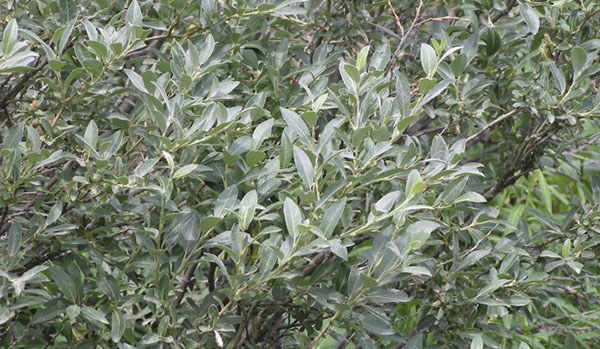Grey willow

Where is it found?
See the distribution map (when page opens, just click on the green ‘search’ button without changing any of the settings).
What does it look like?
Grey willow (Salix cinerea), also know as pussy willow (because of its flowers, see below) and grey sallow, grey willow is a deciduous shrub or small tree that can grow to 7m tall. It spreads by seed or by suckering from the roots. Plants are either male or female. Leaves are 20-70 x 15-35mm, and are oval and serrated. The topsides of the leaves are shiny while the undersides are grey-blue with dense soft grey hairs. Erect cylindrical catkins (15-35mm long) are produced from September to October before the leaves appear. Seed capsules are bivalved and contain many seeds that have fluffy outgrowths and are dispersed by wind.

Why is it a problem?
While not as common as crack willow, grey willows also have been planted in New Zealand as shelter belts, for stock fodder, to prevent soil erosion, and along river and streambanks (riparian zones) to manage watercourses.
- Even the smallest stem fragments can take root anywhere that’s damp, and are readily spread downstream
- Root suckers spread locally
- Cut stumps regrow rapidly
- Grows rapidly, creating dense thickets
- Very tolerant of flooding, can grow in a wide range of temperatures and in semi-shaded areas
- Quickly replaces native species along waterways and forms vast dense (often pure, ie excluding all other plants) stands along channels
- Stabilises braided river gravels, preventing the natural re-shaping of channels during freshes, changing the entire structure and flow of waterways and creating an environment completely unsuited to endemic species.
- Absorbs so much water that river levels can drop and disappear altogether in places
Conservation activities
See Weedbusters for more information.
If you are looking to control willows on your property:
Poisoning method
1. Cut and squirt (summer-autumn) or bore and fill: Make 1 cut or hole every 100 mm around the trunk and saturate each cut or hole with undiluted glyphosate (10ml) or 2,4-D ester (20ml)
2. Frilling (summer-autumn): glyphosate (100ml/L) or 2,4-D ester (200ml/L)
3. Spray (full leaf stage only): glyphosate (12.5ml/L + penetrant, total coverage needed) or metsulfuron-methyl 600 g/kg (5g/10L in December).
Almost all cut stems root where they fall. Cut stumps regrow rapidly. Do not fell unless all plant material can be disposed of at a refuse transfer station or by burning. Best to poison while standing to avoid live stem contact with the ground. Prevent grazing and other disturbance. Interplanting can follow if non-spray follow up control options used.
Non-poisoning method
Cut down and bulldozed into fire pits and burn. Tie or nail sheets of black plastic over stumps to prevent re-growth. Sheep like the salicylic acid in the bark and leaves of the willow and poplar trees, so grazing them on afflicted paddocks will control and in some places prevent re-growth.
